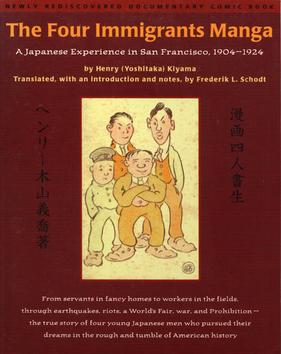The Four Immigrants Manga facts for kids
| The Four Immigrants Manga | |

First English-language edition of The Four Immigrants Manga (Stone Bridge Press, 1998)
|
|
Quick facts for kids 漫画四人書生(Manga Yonin Shosei) |
|
|---|---|
| Genre | Autobiographical, Immigrants, Comedy, Daily life |
| Manga | |
| Written by | Henry (Yoshitaka) Kiyama |
| English publisher | |
| Published | 1931 (U.S.) |
| Volumes | 1 |
The Four Immigrants Manga (1931) is a Japanese comic book, also known as The Four Students Manga (漫画四人書生, Manga Yonin Shosei, "manga of the four students"). It was written and drawn by Henry Kiyama (born Yoshitaka Kiyama (木山義喬, Kiyama Yoshitaka), 1885–1951). This manga is an early example of an autobiographical comic, meaning it tells a true story about the author's own life.
The manga was created between 1924 and 1927. It had 52 parts, called "episodes," each taking up two pages. Kiyama planned for these to be printed in a Japanese newspaper. In 1927, the original drawings were shown at an exhibit in San Francisco. In 1931, Kiyama printed the book himself in San Francisco. Later, in 2012, it was published again in Japan. An English version, translated by Frederik L. Schodt, came out in 1998. In 2017, the manga was even turned into a musical called The Four Immigrants: An American Musical Manga.
Contents
About The Four Immigrants Manga
How the Manga Was Made
Henry Kiyama based The Four Immigrants Manga on his own experiences. He and three friends were young Japanese immigrants in San Francisco between 1904 and 1924. The year 1924 was important because new laws made it harder for people from Asia to immigrate. Some of the characters in the story decided to go back to Japan then.
Kiyama was inspired by Western comic strips. He drew each part of Four Immigrants across two pages. There were 52 parts, enough for a year of weekly newspaper comics. Each part had a funny ending but also told a piece of the story. Kiyama tried to get his manga printed in a Japanese newspaper in San Francisco, but he wasn't successful.
In 1927, Kiyama showed his manga pages at an exhibit in San Francisco. The exhibit was called "A Manga North American Immigrant History." In 1931, Kiyama had the book printed in Japan and then sold it himself in San Francisco.
What the Story is About
The manga shows the immigrants' journey, including their arrival and time in quarantine at Angel Island. It also covers big events from that time:
- The 1906 San Francisco earthquake
- The Panama–Pacific International Exposition of 1915 (a large world's fair)
- The 1918 flu pandemic
The story also touches on how some laws tried to limit Asian immigration. Most of the manga focuses on the experiences of student immigrants before the Gentlemen's Agreement of 1907, which was an agreement between the U.S. and Japan about immigration.
In the original manga, Kiyama had the Japanese immigrants speak in old-fashioned Japanese. The American characters spoke in broken English, and the Chinese characters spoke in Cantonese. When Frederik L. Schodt translated the manga into English, he kept the Americans speaking broken English. However, he made the immigrants speak perfect English. This helped readers see the Japanese characters as "us" and the Americans as sometimes strange foreigners.
Schodt found Kiyama's work in a library in 1980. He started translating it in 1997, and it was published in 1998. After talking to Kiyama's family in Japan and looking at his old papers, Schodt believes that the characters Charlie, Frank, and Fred are based on real people Kiyama knew. Schodt also thinks this manga is one of the first "journalistic comic books," meaning it tells a true story like a newspaper report.
Challenges Faced by Immigrants
The manga also shows some of the difficulties immigrants faced, including racism. At that time, people from different backgrounds often had negative views of each other. This was true for Japanese immigrants and European-American locals. There were also tensions between Chinese and Japanese immigrants in the United States. The manga shows the four immigrants using old terms for white people (keto) and black people (kuroto). This helps us understand how people spoke and thought a hundred years ago.

